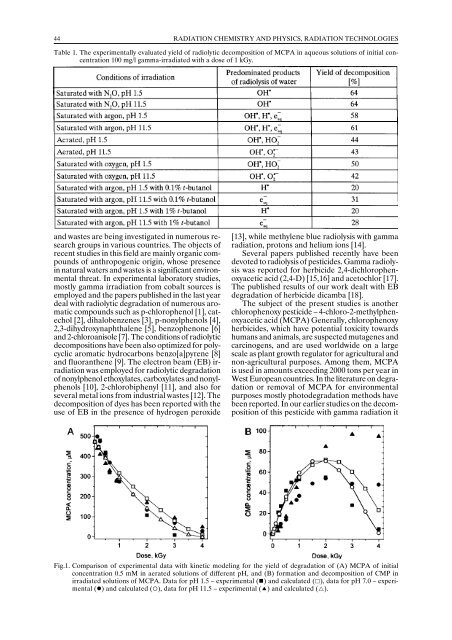annual report annual report annual report annual report 2005
annual report annual report annual report annual report 2005
annual report annual report annual report annual report 2005
You also want an ePaper? Increase the reach of your titles
YUMPU automatically turns print PDFs into web optimized ePapers that Google loves.
44<br />
RADIATION CHEMISTRY AND PHYSICS, RADIATION TECHNOLOGIES<br />
Table 1. The experimentally evaluated yield of radiolytic decomposition of MCPA in aqueous solutions of initial concentration<br />
100 mg/l gamma-irradiated with a dose of 1 kGy.<br />
and wastes are being investigated in numerous research<br />
groups in various countries. The objects of<br />
recent studies in this field are mainly organic compounds<br />
of anthropogenic origin, whose presence<br />
in natural waters and wastes is a significant environmental<br />
threat. In experimental laboratory studies,<br />
mostly gamma irradiation from cobalt sources is<br />
employed and the papers published in the last year<br />
deal with radiolytic degradation of numerous aromatic<br />
compounds such as p-chlorophenol [1], catechol<br />
[2], dihalobenzenes [3], p-nonylphenols [4],<br />
2,3-dihydroxynaphthalene [5], benzophenone [6]<br />
and 2-chloroanisole [7]. The conditions of radiolytic<br />
decompositions have been also optimized for polycyclic<br />
aromatic hydrocarbons benzo[a]pyrene [8]<br />
and fluoranthene [9]. The electron beam (EB) irradiation<br />
was employed for radiolytic degradation<br />
of nonylphenol ethoxylates, carboxylates and nonylphenols<br />
[10], 2-chlorobiphenyl [11], and also for<br />
several metal ions from industrial wastes [12]. The<br />
decomposition of dyes has been <strong>report</strong>ed with the<br />
use of EB in the presence of hydrogen peroxide<br />
[13], while methylene blue radiolysis with gamma<br />
radiation, protons and helium ions [14].<br />
Several papers published recently have been<br />
devoted to radiolysis of pesticides. Gamma radiolysis<br />
was <strong>report</strong>ed for herbicide 2,4-dichlorophenoxyacetic<br />
acid (2,4-D) [15,16] and acetochlor [17].<br />
The published results of our work dealt with EB<br />
degradation of herbicide dicamba [18].<br />
The subject of the present studies is another<br />
chlorophenoxy pesticide – 4-chloro-2-methylphenoxyacetic<br />
acid (MCPA) Generally, chlorophenoxy<br />
herbicides, which have potential toxicity towards<br />
humans and animals, are suspected mutagenes and<br />
carcinogens, and are used worldwide on a large<br />
scale as plant growth regulator for agricultural and<br />
non-agricultural purposes. Among them, MCPA<br />
is used in amounts exceeding 2000 tons per year in<br />
West European countries. In the literature on degradation<br />
or removal of MCPA for environmental<br />
purposes mostly photodegradation methods have<br />
been <strong>report</strong>ed. In our earlier studies on the decomposition<br />
of this pesticide with gamma radiation it<br />
Fig.1. Comparison of experimental data with kinetic modeling for the yield of degradation of (A) MCPA of initial<br />
concentration 0.5 mM in aerated solutions of different pH, and (B) formation and decomposition of CMP in<br />
irradiated solutions of MCPA. Data for pH 1.5 – experimental (•) and calculated (), data for pH 7.0 – experimental<br />
(•) and calculated (◦), data for pH 11.5 – experimental () and calculated ().
















